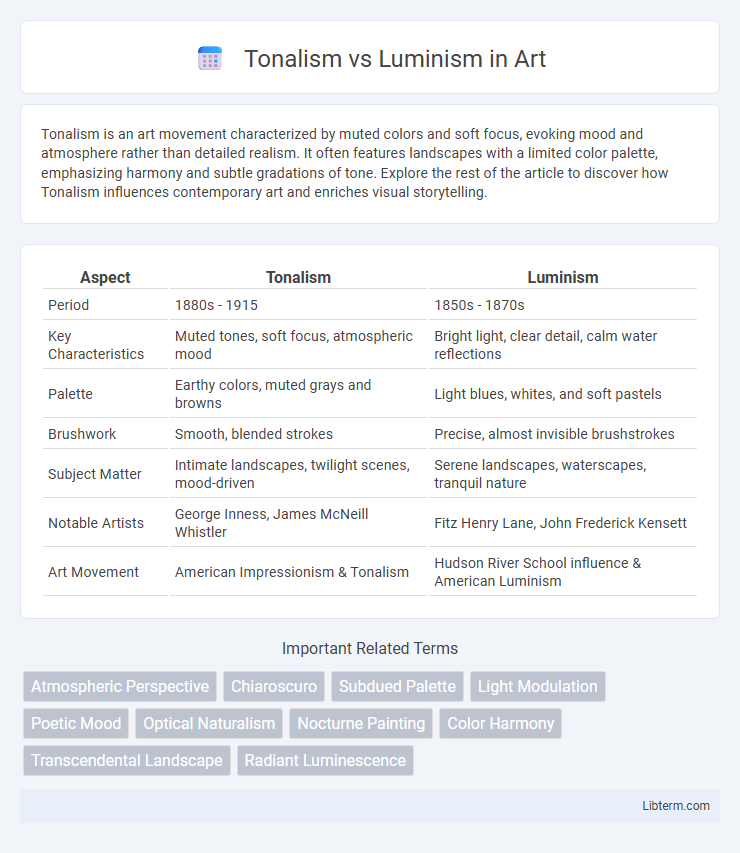Tonalism is an art movement characterized by muted colors and soft focus, evoking mood and atmosphere rather than detailed realism. It often features landscapes with a limited color palette, emphasizing harmony and subtle gradations of tone. Explore the rest of the article to discover how Tonalism influences contemporary art and enriches visual storytelling.
Table of Comparison
| Aspect | Tonalism | Luminism |
|---|---|---|
| Period | 1880s - 1915 | 1850s - 1870s |
| Key Characteristics | Muted tones, soft focus, atmospheric mood | Bright light, clear detail, calm water reflections |
| Palette | Earthy colors, muted grays and browns | Light blues, whites, and soft pastels |
| Brushwork | Smooth, blended strokes | Precise, almost invisible brushstrokes |
| Subject Matter | Intimate landscapes, twilight scenes, mood-driven | Serene landscapes, waterscapes, tranquil nature |
| Notable Artists | George Inness, James McNeill Whistler | Fitz Henry Lane, John Frederick Kensett |
| Art Movement | American Impressionism & Tonalism | Hudson River School influence & American Luminism |
Understanding Tonalism: Definition and Origins
Tonalism is an American art movement originating in the late 19th century characterized by muted color palettes and soft, atmospheric effects that emphasize mood and shadow rather than detail. Rooted in the influence of the Barbizon School and closely linked to American landscape painters such as George Inness, Tonalism seeks to evoke emotional resonance through subtle gradations of tone and a limited range of colors. Unlike Luminism, which highlights sharp clarity and light effects, Tonalism presents a more introspective and poetic interpretation of nature, focusing on twilight or misty scenes.
Luminism Explained: Key Characteristics and History
Luminism is an American painting style from the mid-19th century characterized by its meticulous attention to light, atmosphere, and detail, often portraying serene landscapes with calm water and clear skies. Key characteristics include soft, diffused light, smooth brushwork that conceals the artist's hand, and an emphasis on tranquility and clarity, distinguishing it from the moodier tones of Tonalism. Prominent Luminist artists such as Fitz Henry Lane, Martin Johnson Heade, and John F. Kensett contributed to its development during the Hudson River School and American landscape tradition, highlighting nature's luminous beauty through precise lighting effects.
Artistic Techniques: Tonalism vs Luminism
Tonalism employs muted tones and soft, diffused light to create atmospheric effects and evoke mood, often using a limited color palette with emphasis on shadow and silhouette. Luminism focuses on precise detail, clarity, and the effects of natural light, utilizing smooth brushwork and bright, glowing colors to capture tranquility and luminosity in landscapes. These contrasting techniques highlight Tonalism's moody ambiance versus Luminism's crisp radiance and spatial depth.
Color Palettes and Light: Contrasting Approaches
Tonalism employs subdued, muted color palettes dominated by grays, browns, and dark greens to evoke mood and atmosphere, creating a soft, misty light that blends objects into a harmonious whole. Luminism emphasizes bright, clear colors with precise light effects, often portraying sunlight and reflections with sharp contrasts and meticulous attention to detail to capture clarity and tranquility. These contrasting approaches to color palettes and light define Tonalism's introspective ambiance versus Luminism's emphasis on luminous realism.
Influential Tonalist Artists and Their Works
Influential Tonalist artists such as James McNeill Whistler and George Inness emphasized muted color palettes and soft, atmospheric effects to evoke mood and introspection in their landscapes. Whistler's "Nocturne in Black and Gold" and Inness's "The Lackawanna Valley" exemplify this subtle gradation of tone and intimate sensibility. Their works contrast with Luminism's focus on detailed light effects and clarity, marking a distinct shift toward poetic ambiguity in American art.
Notable Luminist Painters and Masterpieces
Notable Luminist painters such as John Frederick Kensett and Fitz Henry Lane are renowned for their meticulous attention to light and atmospheric effects, exemplified in masterpieces like Kensett's "Lake George" and Lane's "Causeway." Luminism emphasizes clarity, calmness, and detailed rendering of nature, distinctly contrasting Tonalism's muted palettes and mood-driven compositions. These works capture serene landscapes with smooth brushwork and subtle light reflections, marking a key development in American art history.
Emotional Impact: Mood in Tonalism and Luminism
Tonalism evokes a contemplative and introspective mood through its use of muted palettes and soft, diffused light, creating a sense of quiet melancholy and emotional depth. Luminism highlights clarity, brightness, and detailed light effects, generating a serene, uplifting atmosphere that emphasizes tranquility and harmony with nature. The emotional impact in Tonalism leans toward intimate reflection, while Luminism conveys peaceful optimism and luminous calm.
Subject Matter: Landscapes and Beyond
Tonalism emphasizes moody, atmospheric landscapes often depicted at twilight or dawn, highlighting subdued color palettes and misty environments. Luminism captures detailed, calm waterways and coastal scenes with sharp focus on light effects and clarity, portraying serene skies and reflective surfaces. Both movements prioritize natural landscapes but differ in emotional tone and treatment of light, with Tonalism favoring introspective moods and Luminism celebrating luminous precision.
Legacy and Influence on Contemporary Art
Tonalism's legacy endures in contemporary art through its emphasis on mood, atmospheric depth, and subtle gradations of color, influencing modern painters who seek to evoke emotional resonance in landscapes. Luminism's precise attention to light effects, clarity, and detailed representation continues to inspire present-day artists focused on realism and the interplay of natural light. Both movements have shaped contemporary practices by prioritizing sensory experiences and fostering innovations in the portrayal of environment and ambiance.
Choosing Your Style: Tonalism or Luminism?
Choosing between Tonalism and Luminism depends on your preference for mood versus light effects in landscape painting. Tonalism emphasizes muted color palettes and soft, atmospheric scenes to evoke emotional depth, while Luminism highlights clarity, detailed brushwork, and the precise depiction of natural light and reflections. Artists seeking a contemplative, moody aesthetic may lean towards Tonalism, whereas those aiming to capture luminosity and crisp detail often choose Luminism.
Tonalism Infographic

 libterm.com
libterm.com